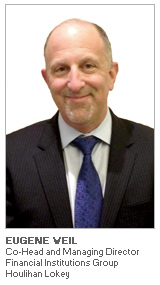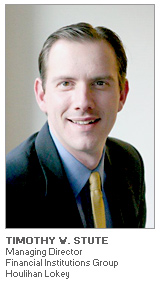
Hardly a week had passed in the New Year when the commercial finance industry learned that Washington, D.C.-based Milestone Advisors had been acquired by the global investment banking firm Houlihan Lokey. The transaction, which closed on December 31, 2012, was of particular interest to asset-based lending, factoring and equipment finance professionals given the fact that Milestone had in recent memory played an active role in nearly every M&A transaction involving a commercial finance platform.
To gain a better grasp on the opportunities both firms saw in Houlihan Lokey's acquisition of Milestone, ABL Advisor spoke with Milestone’s founding partner Gene Weil and managing director Tim Stute. But, as Weil points out, to understand the rationale, it’s important to first understand all that the former independent investment bank brought to the table.
To begin at the very beginning, Milestone was founded in early 2001 with the intention of creating a niche investment banking firm focused on the financial services sector. Weil explains, “Most people in commercial finance probably know our core areas of expertise at Milestone as working with middle-market banks and thrifts and specialty finance companies, both in raising capital and executing M&A deals. And we define specialty finance as both commercial and consumer finance products that are not traditionally found in a bank. We’ve also been very involved in the mortgage space, which we regard as a separate vertical.”
 With deep expertise and active participation in ABL and equipment lending on the commercial side and auto loans, student loans and structured settlements on the consumer side along with a host of other competencies, the firm also developed comprehensive loan analytics and valuation and portfolio sales capabilities. Weil notes that since 2009, Milestone had been an active advisor for the FDIC, for banks and hedge funds concerning their distressed loan portfolios.
With deep expertise and active participation in ABL and equipment lending on the commercial side and auto loans, student loans and structured settlements on the consumer side along with a host of other competencies, the firm also developed comprehensive loan analytics and valuation and portfolio sales capabilities. Weil notes that since 2009, Milestone had been an active advisor for the FDIC, for banks and hedge funds concerning their distressed loan portfolios.
Weil says, “That is how Milestone’s day-to-day operations looked at the end of last year when we did the transaction. We had come off a record year in 2012 and we were very happy where we were and where we were positioned in the market. At the same time, we looked around and determined that if we really wanted to take our practice to a whole new level and start to think about multiples of revenues that we had done at Milestone, we needed to affiliate with a larger firm … somewhere that we’d have more arrows in our quiver.”
Such an affiliation was a concept whose time had come and Weil explains the two firms had considered joining forces once before. “That was in 2008. Back then, the Houlihan team saw us as a good fit as they looked at opportunities in financial services … something they had been a bit underweighted in. But in September of that year, the world went over a cliff and we both said, ‘Let’s talk once we’re on the other side of this.’”
From Houlihan Lokey’s perspective, the transaction represented an opportunity to acquire a cohesive and focused group. Weil notes, “We had established a nice brand and it was a chance to take their existing staff of ten within Houlihan’s Financial Institutions Group and add them to our staff of 25 and wind up with a pretty comprehensive group. For the heritage Milestone staff, the opportunity provided the chance to pick up additional verticals in financial services. “Houlihan has been very active in the insurance sector, the broker/dealer sector and in asset management. There was also some overlap on the specialty finance and mortgage sides of the business, but this has really given us an extension in the areas of financial services we were already heavily involved in … and I think this too was very attractive to both firms.”
As for the arrows and quivers Weil mentioned earlier, he is quick to point out that Houlihan Lokey holds the distinction of being the number one M&A firm for deals under $1 billion in the country. Along with that distinction comes one of the largest restructuring practices, equity and debt capital market capabilities and an extensive reach into the financial sponsor community. He concludes, “From the Milestone perspective, we looked across the Houlihan platform and recognized that we’d be able to keep our entire team intact and take advantage of the extension into the other areas of financial services, which we think are synergistic with the bank, specialty finance and mortgage work we are already doing. Given the reach of the Houlihan platform, we are confident that we are going to see a lot of opportunities arise where we think we can provide a good deal of assistance. And that’s particularly in the Houlihan sponsor practice and with their equity and debt capital markets platform. We’ve raised a lot of capital in our day, but this extends our reach significantly.”
 For Stute, that future is now. He explains, “Even though it’s been such a short period of time since the transaction closed, our group has received a significant amount of phone calls from other parts of Houlihan Lokey with deal ideas and potential referrals. Personally, I’m juggling three or four things that didn’t originate from me or the Milestone team … they originated from our new colleagues. And that’s pretty exciting.”
For Stute, that future is now. He explains, “Even though it’s been such a short period of time since the transaction closed, our group has received a significant amount of phone calls from other parts of Houlihan Lokey with deal ideas and potential referrals. Personally, I’m juggling three or four things that didn’t originate from me or the Milestone team … they originated from our new colleagues. And that’s pretty exciting.”
Weil agrees. “Without a doubt, Houlihan is quite a bit larger than Milestone was. But even given its size, the firm maintains an entrepreneurial culture. The Houlihan people have the ability and drive to be nimble and reactive to opportunities as they arise. As Tim said, it’s been a short while and we’ve already seen that kind of response … that means a great deal to us.”
As the former Milestone team settles into the new opportunities made possible by the Houlihan acquisition, I asked the two to weigh in on the state of commercial finance M&A activity. Stute, who recently authored an article for ABL Advisor on the topic notes, “If you look back, 2012 proved to be very active. Houlihan’s Financial Institutions Group sold a couple of commercial finance portfolios and at Milestone we closed or announced a total of 8 commercial finance platform or portfolio transactions. And these came in all different sizes. As the calendar has now turned to 2013, competition among both the banks and non-bank commercial lending communities has really intensified. As a result, we’ve been seeing more interest being expressed from a variety of buyers in acquisitions in these commercial asset classes. Likewise, we’ve seen some sellers begin to contemplate a sale.”
And for Stute, it’s reminiscent of the way banks were operating in the 2006 to 2007 period. “It’s a bit scary how quickly we’ve gotten back to that. For some commercial lenders, it’s making sense for them to start thinking about selling their platforms since the banks and larger finance companies are growing more and more desperate to find yield and an origination platform to help them grow,” he says.
Weil adds, “We’ve probably seen a broader set of buyers and types of buys than we’ve seen before. Banks and other finance companies are really looking to leverage their infrastructures. We’re seeing the private equity and hedge fund communities stepping up because there’s pretty good access to financing right now. We’re also seeing insurance companies take a real interest as they look for good risk-adjusted yields and like a lot of other investors, trying to diversify from their real estate concentration. And we’re seeing new guys like BDCs [business development companies] and other types of capital intensive vehicles take a real interest as well. We think that given that perspective buyer universe, it really portends very well from a value perspective for a seller or a lender looking for capital.”
But does a greater interest in the sector and a broader set of prospective buyers all add up to good news for the commercial finance sector as a whole? Stute is not 100% convinced. “My only question is that given the fact that things have returned to such a competitive state so quickly, are the banks and non-bank finance companies for that matter reaching on credit as they did in the days before the recession in the name of gaining growth?” In other words, will this heightened activity in time cause a setback from the standpoint of credit quality?
“Well, it may,” says Stute. “But the good news is, banks on the whole are far better capitalized these days and the non-bank finance companies are certainly less levered. So these lenders should be better equipped to deal with a momentary blip in write-offs. But it may be just me … when I see people growing at this quick a clip; it has me question what they might be doing to their credit underwriting box in order to book these assets.”
Weil notes, “Or they could be bringing down the yield on the assets … floating deals at a lower cost of funds. So to Tim’s question, are some of these folks relaxing their credit analytics or lowering their yields to a point that could prove harmful down the road?"
Wherever we end up down the road, Weil reiterates that for today, capital is flowing into the commercial finance sector and the interest in lending to the sector has expanded to include some new players. And that, he says, has created a level of competition and a desire for growth that has definitely impacted yields.
Whether the sector expands or retrenches, both Weil and Stute emphasize the fact that the Milestone approach is not destined to be a thing of the past. Stute says, “Mostly I want your readers to know that I will continue to be the face of our group at Houlihan in the CFA, IFA and ELFA circles. I want people to take comfort in the fact that we’re not changing on that front … and they can count on our established approach to being a reliable advisor for commercial finance companies of all sizes. Whether it’s a sell-side M&A, a buy-side M&A or capital raising, the Houlihan mandate is for that approach to continue.
“But what’s really positive is when you plug us into an 850-person company whose professionals have the day-to-day job of calling on 600 plus private equity firms and hedge funds, it’s a level that we couldn’t achieve at Milestone. Not to mention that now we have access to an equity capital markets desk that can do capital raises publicly through a partner and privately along with a debt capital desk that can help us in providing innovative structures for our clients. I couldn’t be more excited about our future.”
Once again, Weil concurs with his colleague. “I couldn’t agree more and I think this allows us to do some things for some of the much larger players in the sector, particularly on the equity and debt capital markets side. I think what Tim said is completely right … today we have 100% of the Milestone resources that we had before plus 100% of Houlihan Lokey’s resources which serves to position us nicely for the future.”